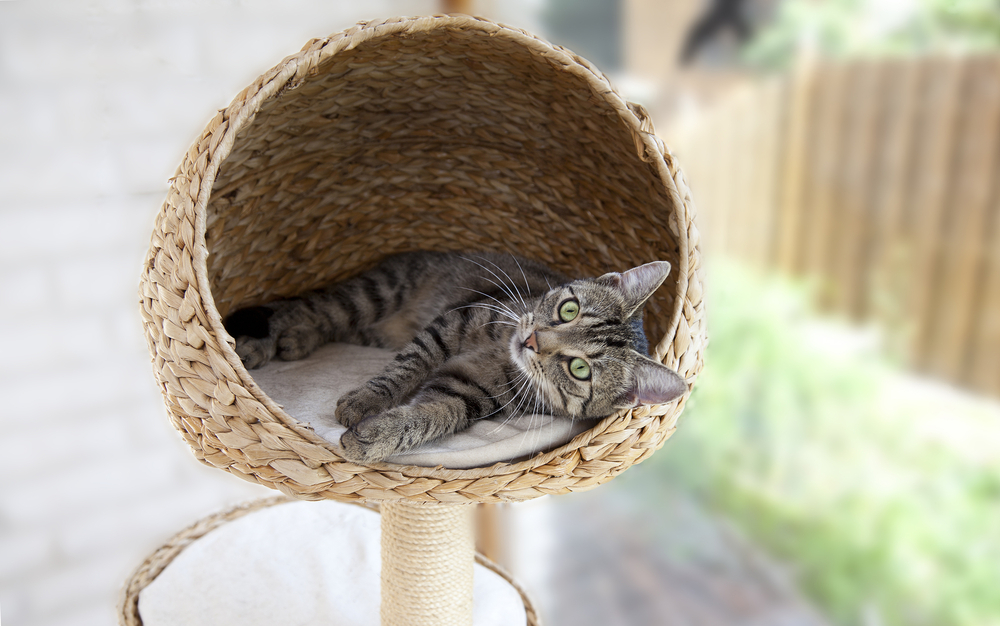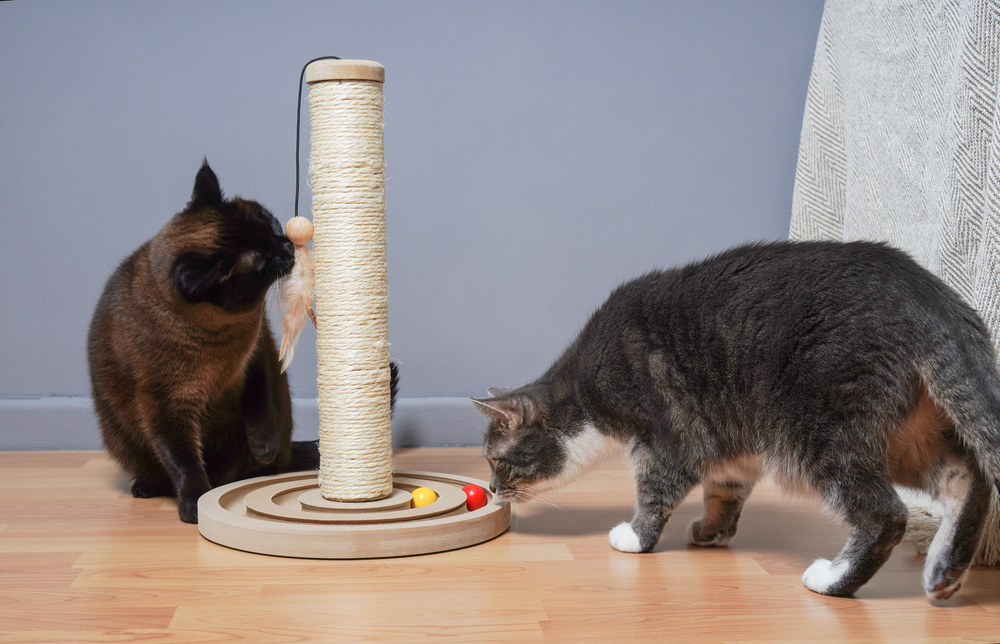While being quarantined at home during this COVID-19 pandemic, we’ve learned that environmental enrichment is crucial for our mental health. Although we knew there would be a light at the tunnel, many of us went stir-crazy, cooped up at home, day after day, with little to no interaction with the outside world. Now we know exactly how our pets feel, especially cats. House cats can become stressed if their environmental enrichment is inadequate, developing problem behaviors, or physical medical conditions, like feline idiopathic cystitis. Signs your cat may be stressed because they have too few enrichment activities, toys, or play options include:
- Inappropriate elimination
- Gastrointestinal changes (i.e., vomiting, diarrhea, flatulence)
- Increased grooming and hairballs
- Decreased appetite
- Hiding
Keep your feline friend happy and healthy by offering a variety of environmental enrichment options that cater to your cat’s natural behaviors. Reduce their stress by allowing them to engage in their natural behaviors, such as climbing, scratching, and hunting, which will not only make your pet happy, but also contribute to their overall well-being.
Although your little puma is now a housecat, they still need to practice natural instincts and behaviors they would perform in the wild. Help your feline friend unleash their wild side through a variety of environmental enrichment options. Here are five ways to spice up your cat’s home life.
#1: Create a vertical playground for your cat
Cats are a unique species in that they are both predator and prey. As such, they enjoy climbing up high, to better survey their territory, or rest safely. Cater to your feline friend’s dual personality by creating a vertical playground with plenty of climbing towers, wall shelves, and lookout perches, to keep them happy and secure.
While placing a climbing tower next to a window with a view is ideal, you can take things a step further, and build a luxury outdoor catio that you outfit with ramps, “trees,” perches, and platforms with a variety of scratching surfaces. Make the catio more appealing, and provide visual stimulation, by placing a birdbath and bird feeder nearby. Most cats will watch the fluttering entertainment and enjoy the show. However, ensure your cat does not become too worked up at the sight of feathery prey, and attempt to escape to chase down a bird.
#2: Offer your cat a variety of scratching options
Cats scratch to fulfill three basic needs—mark territory, practice nail care, and stretch after resting. To meet those needs, provide multiple scratching posts with different surfaces in your cat’s favorite spots. Cats often prefer sisal rope surfaces, but may also like carpeted posts. In addition, ensure vertical scratching posts are as tall as your cat when stretched out. The best spots for scratching posts and horizontal scratch pads are near your cat’s resting areas, beside windows, and next to furniture.
#3: Purchase prey-like toys that encourage your cat to hunt
Many feline toys are geared toward fulfilling a cat’s desire to hunt, inciting stalking, chasing, pouncing, and capturing behaviors. Feather wands, and fishing pole, kicker, and robotic toys cater to your cat’s natural instincts by allowing them to stalk and pounce on their prey. You can also toss plush catnip mice down the hall for your cat to chase and capture, or create a cardboard tunnel maze with hidden “prey” at the end.
#4: Use food puzzles to feed your cat
Ditch the dish when feeding your cat. More than half of America’s cats are overweight or obese, since many cats are free-fed, and always have a full food dish. In addition to encouraging your cat to burn calories before consuming more, food puzzles help provide mental enrichment. Many commercial food puzzles are available, or you can create your own from household items. Design a snuffle box by crumpling paper balls wrapped around a few pieces of kibble that will encourage your cat to scoop out the bites. You can also fold the ends of a cardboard tube riddled with holes, and filled with kibble for your cat to bat around.
#5: Offer various hiding spots for your cat to rest and recharge

Cats can sleep up to 16 hours per day, and as prey animals, they need to feel safe and secure to comfortably rest. Most of the time, cats sleep “with one eye open,” staying alert to sounds in their environment. With dark, quiet, and especially high, places to hide, you’re providing your cat the most peaceful, restful, sleeping spots.
Here at Bassler Veterinary Hospital, we understand how a cat’s mind operates. To help our feline patients live happy, enriched lives, we focus on catering to their needs at home, and in our hospital. For personalized ways to enrich your cat’s environment, and reduce stress and boredom, schedule a feline behavior consultation with Dr. Bassler.








Leave A Comment